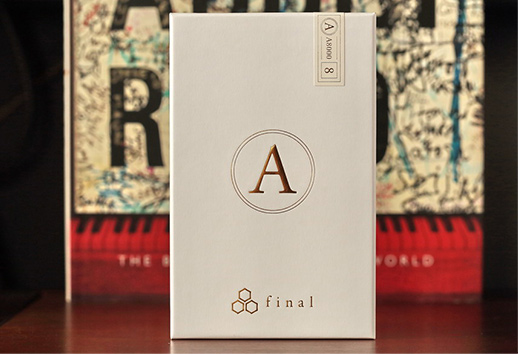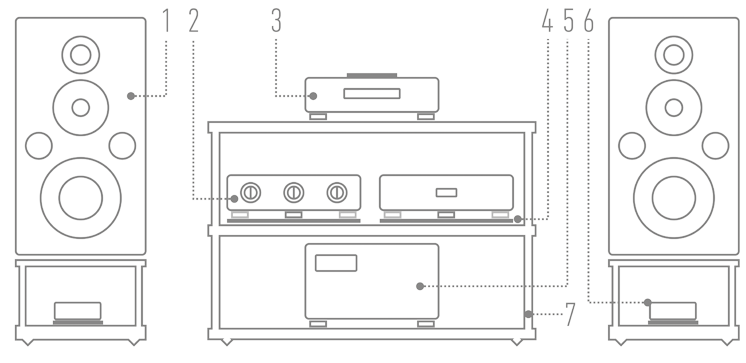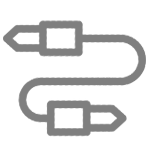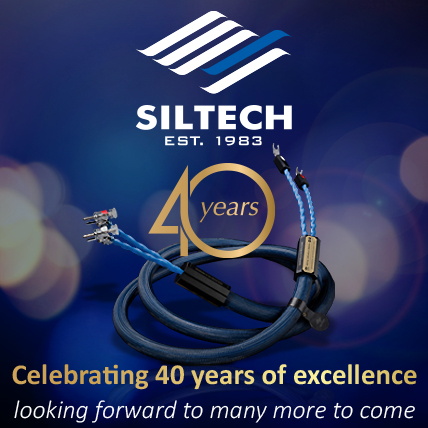|
Earphones Final
Manufacturer: S’NEXT Co., Ltd. |


|

|

The Final Audio Design company was established in 2007, as part of the American Molex company, a manufacturer of plugs and ports for audio devices. The aim of the cooperation was to develop headphones and a new generation of loudspeakers. The former became the main focus of the collaboration and the FINAL company today is associated with headphones. As a result, the first Pianoforte IX earphones were launched onto the market in 2009. In 2014, Final became an independent brand, owned by the Japanese company S’Next. | THE A8000 The Final company’s offer includes a few independent product series, the main ones being A, D, B, E, F and Sonorous. Apart from them, there is also the MAKE series that makes it possible for the listener to select one of many filters and adjust sound to one’s own requirements. There are many more series and they are all presented on the MANUFACTURER’S or the DISTRIBUTOR’S websites. As you may have guessed, the letters in the names of the series show a clear hierarchy; while the D series is at the same level as the A series, it also includes headphones. | IEM = IN-EAR MONITORS 
The A8000 are representative of what is called IEM in the literature. IEM stands for in-ear monitors. It is a category of earphones invented and developed by the professional audio industry in mid 1980s. They are used by artists to monitor sound during concerts and replace classic stage monitors, i.e. loudspeakers. Alongside the development of the audio industry following the smartphone revolution, they have been adapted for use with mobile devices (smartphones, tablets, laptops, etc.). Timeline | As I wrote while testing the over-ear D8000 headphones in 2018, the Final company started working on a new type of headphones quite a long time ago, in 2014. The work was completed in May 2017, i.e. before the High End 2017 exhibition, where the abovementioned D8000 model was presented. The press wrote about the latest Final earphones – the A800 – on 23rd November 2019. These are earphones designed to work with mobile devices. While working on a “large” model, subjective sound assessment was mainly used, while attempts were also being made to maintain as flat frequency response as possible. The problem was that it was not possible due to time shifts. That is why a methodology called Perceptual Transparency Measurement (PTM) was created for the purposes of designing the A8000. It combines technical measurements with subjective listening. Objectives | The main objective to achieve while working on the new earphones was their transparency. It was necessary for the Final company to use a new diaphragm material (beryllium) in order to reach this goal. Beryllium has been known in the audio industry since 1970s and the most well-known loudspeakers from that period that used it were the Yamaha NS-1000M, presented in 1974. Today, the most important manufacturer using such diaphragms was the Focal company. Technology | ultra-thin foil made of Truly Pure Beryllium was used to make the A8000. It is characterized by very low mass and incredibly fast sound wave propagation – only diamond is better in this respect. It is very hard to form a diaphragm using this material, but engineers from the Final company have succeeded in doing so – they make the diaphragms themselves. Beryllium diaphragms operate within metal housings made with extreme precision of polished stainless steel. Their outer shape and the basic mechanical elements have been developed for the B series. In A8000 earphones, more work was devoted to adapting the size and shape of the chambers behind and in front of the diaphragm. As a result, a construction was created in which the space has been divided into four chambers. The idea has been called the “Tetra-Chamber Construction”. 
What is more, the chambers and the diaphragm have been put in an individual housing and thus they are separated from the section to which the cable is attached. It has been done in order to prevent noise and rustling sound transmission through the cable to the ear – something that is really inconvenient while moving around a city. Additionally, noise can be reduced by putting a plastic element (an ear hook) on the cable, letting the user wear the cable around their ear. The hook is also offered by the company. The earphones are connected to the cable using a connector called the MMCX. It was developed by the Final company, which means that we need to use the cables delivered with the earphones (I do not know any other manufacturers that would offer headphone cables equipped with these connectors). |

However, perhaps there is nothing to worry about – the cable looks great and resembles Crystal Cable cables on the outside. It was developed by engineers from the Final company in cooperation with the Junkosha company, a Japanese cable manufacturer. The cable was originally developed to be used with the supercomputer Kei, because of a high signal transmission speed. The insulation is made of PFA developed by Junkosha, while the outer tube is made of classic PVC. The cable is made of silver-coated OFC. The aesthetic impression | The tested earphones resemble jewelry. This statement refers to their looks, but probably even more to the form of their presentation. The carry case is sublime and we know instantly that the style once imposed by the Apple company has also changed the audio industry. It is good, as now it is more civilized and much more attractive. The earphones are packed in a white cardboard box placed in some kind of an “envelope”. 
After opening the package, we see the inside that looks like a Japanese gift: first we remove some material and there is another layer underneath made of paper that looks like rice paper. There are two boxes inside. One, made of black anodized aluminum and silicon, contains the earphones. The other one is for five pairs of silicon earpieces that come in five sizes: SS/S/M/L/LL. Using them, one can adjust the earphones to their ears. It is very important – the ear canal must be tightly closed, or the tonal balance will be too light (there will be too little bass). It is an example of a wonderfully made audio product, perfectly developed in all its aspects.  Almost 9,000 PLN for the earphones is an extremely high price – not only for an average music lover, not to mention teenagers, but for anyone who listens to music. In the end, we pay for something that we can enclose in our hand. On the other hand, it is all about the technology that we could conceive a few years ago, but then it was hard to imagine it being used commercially – and this is always expensive. After crossing the mental price barrier, we need to face our expectations of what the earphones are to do for us. Taking their price into account, it is quite easy to exclude ordinary smartphones and tablets, and solely focus on ultra high-end portable file players. But that’s not the way it is. I have used the A8000 both with my inexpensive Samsung A50 and the professional (it’s in its DNA) Mytek Brooklyn Bridge file player (with a Neutrik adapter). I also used my antique, but still great HiFiMAN file player. Each time, I was surprised with what the earphones can do. The earphones produce incredibly diversified sound that is full of nuances. And they are not tiring. In order to hear what they can do, I sat next to the Mytek player for a long time (the A8000 cable is very short), drinking tea, then coffee, eating grapes and then cookies. In this way, I listened both to popular playlists and mixes, but I spent most of the time with Master playlists. Each time I changed the file quality, first from 16/44.1 to 24/44.1 and then to 24/192, or even 24/384 offered by the Swedish 2L record label, I obtained a noticeable and valuable sound improvement. That means great resolution and differentiation. When it comes to tone color, the tested earphones are somewhere between the low and firm sound of the AKG K3003 (no longer manufactured) and the slightly lighter, but still strongly saturated sound of the Focal Sphear. We only need to remember about fitting them tightly into our ears (it can be done very precisely), or they quickly lose bass. The treble is the most impressive. There is not little of it, but it has the character that I know from beryllium Focal tweeters. It is an incredible and unique combination of resonance with delicacy and silkiness. Overall, the treble is quite warm here, but this is not especially audible in details. Higher treble is a little emphasized, which gives the impression of sound openness. The sound lacks the lowest bass, which is shown by a comparison of the earphones with over-ear headphones, but IEM models simply sound like this, no matter how much they cost. However, the A8000 model is characterized by extremely well-balanced tone color, thanks to which we will not miss anything. Driven by a high-quality amplifier, the earphones showed so much with the Mytek file player and in such a refined manner that, I swear, I did not miss the momentum of large planar headphones. | CONCLUSION The Final A8000 are the most expensive earphones/in-ear monitors that I have listened to with my system. And they are the best of all the models that I have tested. They are quite heavy, so one needs to carefully select the silicon earpieces and find the right angle for inserting them into the ear. This can be done and, after a few attempts, they would stay in place without any problems, even when I moved my head. The earphones cannot be used for running, but they are perfectly suitable for moving around in a city. 
However, their use is not limited to mobile applications. I do not want to confuse you, but I can say I can imagine myself sitting at my desk with a DAC or a file player as good as the Mytek Brooklyn Bridge, listening to music from the A8000 and not from over-ear headphones. It is not because the Final earphones are better than, let’s say, the HiFiMAN HE-1000 V2 or the Audeze LCD-3, absolutely not! However, they are good enough to make the differences insignificant to us. Yes, they are such high-quality earphones… ■  Technical specifications (according to the manufacturer) Housing: stainless steelDiaphragm: beryllium, dynamic Sensitivity: 102 dB/mW Impedance: 16 Ω Weight: 41 g Cord length: 1.2 m |

|
Reference system 2018 |
|
 1) Loudspeakers: HARBETH M40.1 |REVIEW| 2) Line preamplifier: AYON AUDIO Spheris III Linestage |REVIEW| 3) Super Audio CD Player: AYON AUDIO CD-35 HF Edition No. 01/50 |REVIEW| 4) Stands (loudspeakers): ACOUSTIC REVIVE (custom) |ABOUT| 5) Power amplifier: SOULUTION 710 6) Loudspeaker filter: SPEC REAL-SOUND PROCESSOR RSP-AZ9EX (prototype) |REVIEW| 7) Hi-Fi rack: FINITE ELEMENTE Pagode Edition |ABOUT| |
|

|
Cables Analog interconnect SACD Player - Line preamplifier: SILTECH Triple Crown (1 m) |ABOUT|Analog interconnect Line preamplifier - Power amplifier: ACOUSTIC REVIVE RCA-1.0 Absolute-FM (1 m) |REVIEW| Speaker cable: SILTECH Triple Crown (2.5 m) |ABOUT| |

|
AC Power Power cable | Mains Power Distribution Block - SACD Player: SILTECH Triple CrownPower (2 m) |ARTICLE| Power cable | Mains Power Distribution Block - Line preamplifier - ACOUSTIC REVIVE Power Reference Triple-C (2 m) |REVIEW| Power cable | Mains Power Distribution Block - Power amplifier - ACROLINK Mexcel 7N-PC9500 |ARTICLE| Power cable | Power Receptacle - Mains Power Distribution Block: ACROLINK Mexcel 7N-PC9500 (2 m) |ARTICLE| Power Receptacle: Acoustic Revive RTP-4eu ULTIMATE |REVIEW| Anti-vibration platform under Acoustic Revive RTP-4eu ULTIMATE: Asura QUALITY RECOVERY SYSTEM Level 1 |REVIEW| Power Supply Conditioner: Acoustic Revive RPC-1 |REVIEW| Power Supply Conditioner: Acoustic Revive RAS-14 Triple-C |REVIEW| Passive filter EMI/RFI: VERICTUM Block |REVIEW| |

|
Anti-vibration Speaker stands: ACOUSTIC REVIVE (custom)Hi-Fi rack: FINITE ELEMENTE Pagode Edition |ABOUT| Anti-vibration platforms: ACOUSTIC REVIVE RAF-48H |ARTICLE| Isolators: |

|
Analogue Phono preamplifier: Phono cartridges:
Clamp: PATHE WINGS Titanium PW-Ti 770 | Limited Edition Record mats:
|

|
Headphones Headphone amplifier: AYON AUDIO HA-3 |REVIEW|Headphones: Headphone Cables: Forza AudioWorks NOIR HYBRID HPC |
main page | archive | contact | kts
© 2009 HighFidelity, design by PikselStudio,
projektowanie stron www: Indecity







 he Final Audio Design brand is Mr Kanemori Takai’s brainchild. He is one of the most interesting audio designers from Japan who used to, already before the brand in question was set up, offer both a turntable cartridge in which the cantilever and stylus were made of one piece of diamond (2 carats), as well as the enormous 800 kg Opus 204 loudspeakers with membranes made of ultra-thin aluminum panels filled with sand. The offer also included the extremely impressive Parthenon turntable.
he Final Audio Design brand is Mr Kanemori Takai’s brainchild. He is one of the most interesting audio designers from Japan who used to, already before the brand in question was set up, offer both a turntable cartridge in which the cantilever and stylus were made of one piece of diamond (2 carats), as well as the enormous 800 kg Opus 204 loudspeakers with membranes made of ultra-thin aluminum panels filled with sand. The offer also included the extremely impressive Parthenon turntable.







